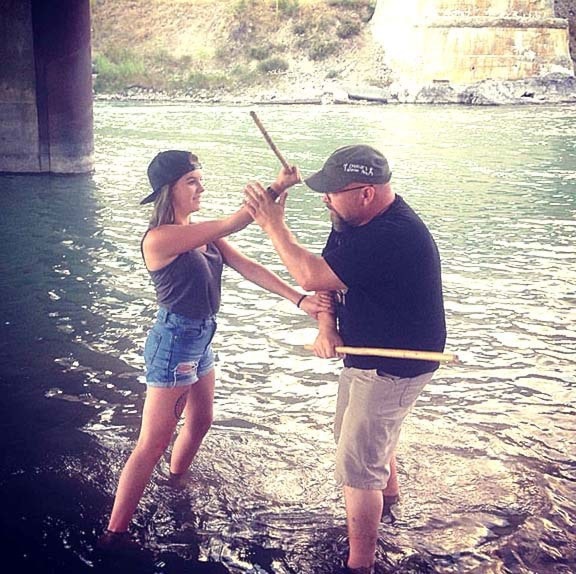Joel Huncar
One of the questions I get asked the most about arnis is a simple one; "why do you train in stick fighting?"
The reason many people ask about this is that there are many misconceptions about arnis and the use of the stick in the Filipino Martial Arts. Most people see it as simply a stick fighting art that practices a weapon system that has little or nothing to do with modern self-protection. This literal idea that training with the stick is the same as fighting with the stick is simply not true.
While I won't deny that most Arnisadors are fantastic stick fighting; however the stick training in arnis goes much deeper than simply fighting with a stick.
In arnis and eskrima the stick is the first phase of training. Fighters learn the stick, the knife, paired weapons; some styles teach long weapons and all systems teach devastating empty hand techniques.
The reason for this learning model was simple; arnis is a system of self-protection, not a sport art or spiritual system, as such the weapons fighting was taught first. After all, you don't go into battle unarmed when it comes to defending your family against bandits and raiders.
Most battlefield arts teach weapons first and empty hand last, simply because empty hand fighting is a last resort in a real life and death struggle.
Unfortunately in the days of seminar instruction a lot of the basics of arnis was taught to the public but many only scratched the surface and began teaching "arnis sticks" as an add on to their base martial arts. The sticks were simply another weapon like the staff, the sword or the nunchaku. These practitioners did not feel the need to learn deeper because in their minds they already had all the empty hand skills they needed. But most understood that the use of the stick was enhancing the empty hand skills they already had. Arnis stick training develops much more in an arnisador than simple stick fighting skills.
One of the other amazing gifts this art gives is the ability to use improvised weapons. Understanding how to generate power, angles of attack and how to move with a weapon can make many everyday objects into tools for self-preservation.
The stick training in arnis really teaches adaptability and creativity when it comes to persona-protection and paves the way for other weapons use such as the sword or the knife.
The training in stick fighting really does a lot for a martial artist speed and coordination. Paired weapons help other martial artist use both hands independently as does the integration of the empty hand in single stick practices. Stick training hardwires reactions to angles of attacks as opposed to learning specific techniques to defend against specific attacks.
Basic arnis training was key to becoming a freer and creative fighter for many martial artists deeply entrenched in other traditions. However, few of these martial arts cross trainers ever delved deeply into the empty hand or edged weapon training of arnis, satisfied as they were for having their base arts enhanced by some basic stick training.
What many of them were missing out on was some of the most effective and unique empty hand training taught in modern martial arts. To see the cinematic versions of these brutal arts you simply have to watch any of the Bourne movies, the last few Denzel Washington action movies, or any of the Taken series. The flow and brutality of Filipino empty hand training definitely looks great on the screen but is even better suited for surviving real world violence. Many military knife systems are based on arnis principals and even Israeli krav maga knife training is based on Filipino knife training.
The empty hand arnis skills are designed to cause pain and damage with every move. Moves with the blade become destructive counter attacks with the elbow. Arnis empty hands techniques are designed to immobilize, control, trap and destroy another human being. There is no sport applications to these moves — after all, things like eye gouging and digit breaking is banned in even the most extreme sport fighting, for obvious reasons. However, these moves are part of the basic tactics of arnis self-defence training.
These techniques used in action movies look deadly, but the real mano-a- mano skills are much more effective and less flashy than those favoured in entertainment. These skills teach the ability to be destructive and flow from weapons to empty hands, striking to trapping and clinching; arnis is one of the broadest skillsets you will find being taught in traditional martial arts. The fluidity and brutality of arnis mano mano is a lot of fun to train and very empowering to have in your back pocket if you ever find yourself in a bad situation.
Your stick may not be with you at the time but your skills always are as long as you work at keeping them sharp.
Joel Huncar teaches Arnis/Eskrima, Muay Thai and children's programs at Huncar's Warrior Arts out of the Rocky Mountain Martial Arts Family Centre
